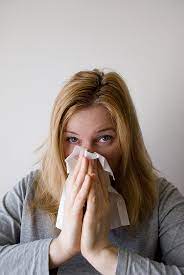While you are trying to listen to your professor lecture about derivatives and integrals, the person sitting less than three feet away from you sneezes: “ACHOO!” You shudder. Perhaps hold your breath. Or scoot your chair a few inches away from them.
One person infected with an illness has the potential to infect 15 out of 100 people within two weeks. While that may not seem like much, this means that up to 15% of the student body of schools that contain thousands of students could be out of commission for a while. To make matters worse, the population has experienced firsthand how the COVID-19 pandemic has negatively affected the economy with temporary and permanent closures of schools and businesses.
“One person infected with an illness has the potential to infect 15 out of 100 people within two weeks.”
With that being said, how are sneezes contagious? And what makes them unique from other modes of transmission?
A sneeze, or sternutation, is a way for the body to get rid of irritants by expelling mucus via the nasal and oral cavities. A sneeze releases 40,000 droplets compared to a cough’s 3,000, which is especially scary for a short person, who is more likely to inhale infected droplets.
Many factors, such as the force of a sneeze or the environment, affect the velocity of a sneeze. According to a study
led by MIT fluid dynamics scientist Lydia Bourouiba, sneeze velocities can reach up to 100 miles per hour.
Larger droplets, more than five to ten microns, usually travel three feet before they fall to the ground due to their density. While their area of impact is smaller, they carry more infectious particles and are more likely to get someone sick. Small droplets, or aerosols, travel further and remain airborne for up to two weeks. They can travel through air vents and make their way into another room, where more victims may lie completely unaware. The more humid a room is, the longer those particles will linger in a cloud of sneeze content.
These pesky aerosols are tiny enough to easily travel deep in a person’s lung. Researchers at the Wake Forest School of Medicine in North Carolina found 89% of flu viruses in particles less than 4.7 micrograms up to 6 feet from a person’s face.
These numbers and statistics can be alarming, but there are many ways to reduce infection transmission. People are taught to cover their mouths and noses when they sneeze, but the angle of the head during a sneeze also plays an important role in reducing the spread; by bending our head down at an angle of 3–43 degrees, people can reduce a sneeze’s infectious distance by 22%.
Droplets move towards the path with the least resistance, meaning that any open area is likely to be the path of a sneeze. One way to minimize open areas is by wearing a mask. While surgical masks like an N95 provide the most protection, even one cloth covering reduces the risk of infection.
One way sickness can spread is by physical contact of droplets to the face. People touch their faces an average of 16 times an hour, so finding other ways to occupy the hands reduces the chance of spreading infection.
Everybody sneezes. It’s one of the body’s mechanisms that free it from irritants and disease. Unfortunately, one may spread such infected particles to others in the process of doing so. The COVID-19 pandemic has been a reminder of the incredibly infectious nature of some diseases. While people may not have batted an eye at someone sneezing in 2018, the pandemic greatly altered the level of caution. Luckily, everyone can reduce the spread, whether that be by wearing a mask or taking a day off when they first feel that tickle in their nose.






